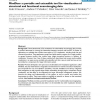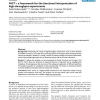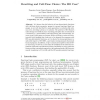687 search results - page 54 / 138 » Feature (De)composition in Functional Programming |
BMCBI
2007
13 years 8 months ago
2007
Background: Three-dimensional (3-D) visualization of multimodality neuroimaging data provides a powerful technique for viewing the relationship between structure and function. A n...
BMCBI
2005
13 years 8 months ago
2005
Background: The identification of local similarities between two protein structures can provide clues of a common function. Many different methods exist for searching for similar ...
BMCBI
2005
13 years 8 months ago
2005
Background: Interpreting the results of high-throughput experiments, such as those obtained from DNA-microarrays, is an often time-consuming task due to the high number of data-po...
ICFP
2005
ACM
14 years 8 months ago
2005
ACM
This paper explains how the high-level treatment of datatypes in functional languages--using features like constructor functions and pattern matching--can be made to coexist with ...
FLOPS
2008
Springer
13 years 10 months ago
2008
Springer
It is known that the behavior of non-deterministic functions with call-time choice semantics, present in current functional logic languages, is not well described by usual approach...



